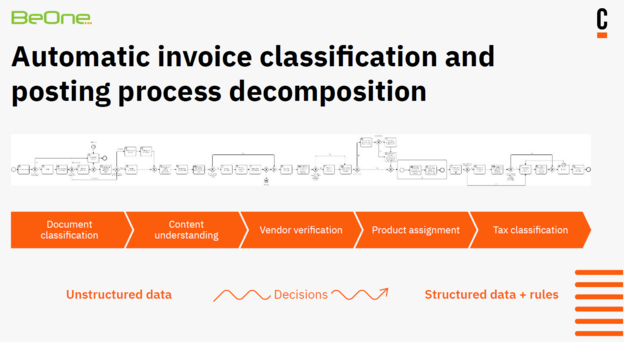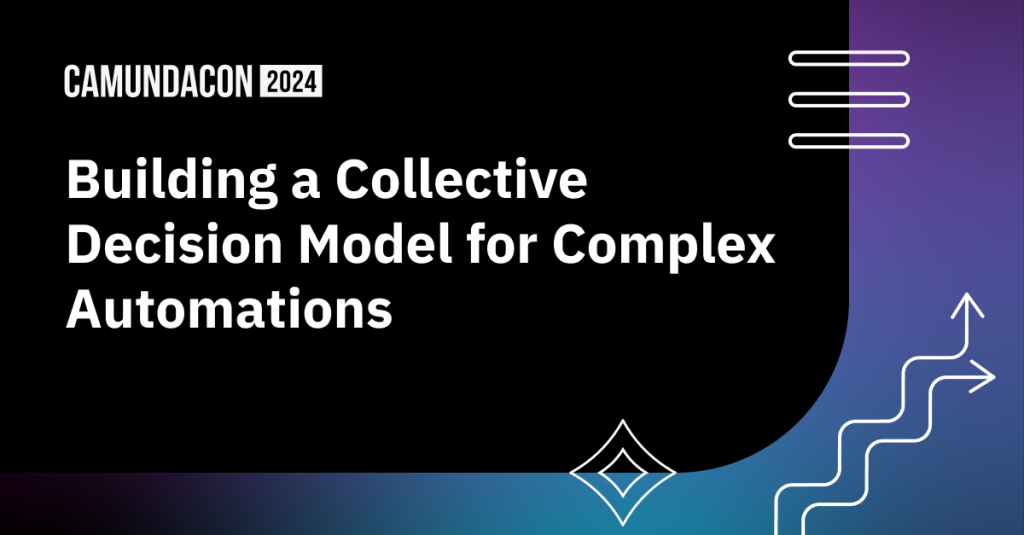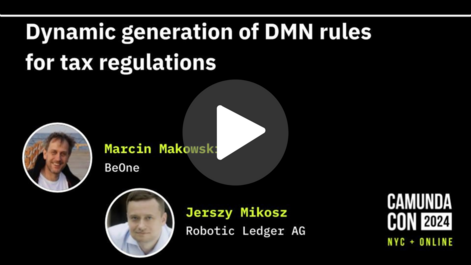For Marcin Makowski, CEO of consulting firm BeOne, and Jerzy Mikosz, founder of Robotic Ledger AG, the democratization of software is about helping small and medium enterprises benefit from powerful software tools such as process orchestration and automation. While larger enterprises are more likely to have the resources to develop automation solutions, application development may not be as cost-efficient for small and medium organizations. Jerzy, Marcin, and their partners are addressing this gap in the market for small and medium enterprises in Switzerland.
Using software to help close the automation gap for small and medium enterprises
Switzerland consists of 26 cantons (federal states), each with its own set of tax regulations. At the 2024 CamundaCon in New York, Marcin and Jerzy explained how they used Camunda to build a “digital accountant” called Luca that helps small and medium enterprises automate and optimize processing for paper accounting forms.
Building a solution to automate multiple clients’ accounting rules
The team had to solve several challenges to develop a solution that would be useful for different organizations and industries. The solution needed to understand tax regulations for each canton and support the multiple official languages of each—a varying combination of German, Italian, French, and English.
It also needed to understand basic accounting principles and learn how to apply those principles in the right context for specific organizations and document types. Plus, it needed the ability to detect accounting items from scanned documents and classify tax-related items correctly for the Swiss system; creating structured data from unstructured content. Transparency was also essential. The business processes and decision models needed to be auditable for regulators.
Because the solution would be hosted in a multitenant environment, the team also needed to ensure secure communication for tenants and subtenants, as well as with Bexio (business software for small businesses and startups) and other accounting systems. And like any good software solution, it needed to be agile and flexible enough to change as tax laws change.
Creating a collective decision model
The development team wanted to create a model to orchestrate manual and automated tasks and use decision tables to store the tribal knowledge of human accountants. Based on BeOne’s demonstrated experience supporting hundreds of thousands of business users with Camunda-built business processes, they were confident they could use Camunda’s BPMN and DMN capabilities to create an agile, dynamic, multitenant solution.
First, they collected and analyzed manual accounting decisions for tasks requiring human assistance. Next, they developed a model to predict behavior and provide automated services based on those predictions. The model also assists with manual decision-making. Finally, they created a feedback loop synchronizing manual and automated tasks, creating a self-sustaining decision model.
The decision model uses decision tables with rules for product determination, product groups, accounting groups, and tax rates. Each table is powered by a combination of rules from the feedback loop and sources like machine learning.
The result is a solution that applies business processes and subprocesses to orchestrate and automate invoice classification and posting from end to end. It can scan and classify documents, recognize invoice items within a document, verify the supplier and payment, detect accounting items and tax rates, make an accounting entry, and post to the accounting system.
If the document and the booking are clear, the solution can post without waiting for confirmation from an accountant. If any information is unclear or requires confirmation, it asks for manual input or verification and stores that knowledge. As feedback increases, the level of automation increases.

Example of the solution’s end-to-end process flow
As the solution is deployed in a multitenant architecture, the team manages the complexity of data security and rule-sharing among multiple clients by establishing tenants for accounting offices and subtenants for their customers. Information from each tenant is shared to a central decision model, then that decision model is used to automate the tenant’s processes.
With this structure, the solution can remember and apply rules and decisions specific to each client and their documents.
Improving automation and efficiency while reducing risk
“Our model is not just win-win but win-win-win.” – Marcin Makowski, CEO, BeOne
Luca’s development team succeeded in building a solution that uses collective human knowledge to accurately execute complex accounting decisions. Its robust decision model provides an auditable knowledge base that applies decisions learned through client use to continually improve the classification of documents and expenses.
The team and their clients are realizing benefits from this model, including:
- Quality, stable processes for items posting in compliance with complex regulations
- Efficiency from the quality of process data and reduction of mistakes
- Risk mitigation through the introduction of control rules
- Transparency from auditable rules and records
- Processing speed delivered through well-performing decision tables, even in tables with up to 1 million rules
- New services developed as a result of well-functioning decision tables
Unique to the business model, clients only pay a fee if Luca delivers an expected outcome—typically, time savings calculated by the automation rate of the process instance. This approach gives small and medium enterprises in Switzerland access to an automated accounting service at an affordable price.
Overall, as Marcin explained, “Thanks to the collected human decisions, we improve the level of automation and reduce decision fatigue for employees, giving them more time and energy to work on more important tasks.”
Refining the model through human training
Marcin and Jerzy showed how a collective decision model can be a versatile, cost-effective way to automate complex processes for multiple users with different requirements. They also demonstrated how taking a dynamic and iterative approach to developing decision-making capabilities allows an organization to go to market with a set of general rules and then expand and refine those rules through user input.
In Luca’s case, once accountants began using the solution, it was able to collect their input via the feedback loop and improve decision-making and automation.
This approach has an advantage over using knowledge gleaned from generative AI because it is true instead of theoretical. In other words, Luca generates correct decisions because it is trained on manual decisions from human accountants. The differentiator in their solution—the human decision—is at the heart of their process.
Inspiring developers to look for new process automation opportunities
This CamundaCon presentation provided an interesting example of how to use a collective decision model to create new automation opportunities for small and medium enterprises. As Jerzy and Marcin pointed out, the amount of unstructured data within organizations continues to increase and, along with it, opportunities to find new automations through interpreting and adding structure to unstructured data.
To see more details on this project, watch the full session replay. Then, check out other CamundaCon presentations for inspiration on new ways to use process orchestration and automation to solve your most complex problems.
Join us in Amsterdam
The next CamundaCon is almost here! It’s not too late to join us on May 14–15 in Amsterdam. Or get ahead of the game and register for CamundaCon 2025 in NYC this October.




Start the discussion at forum.camunda.io